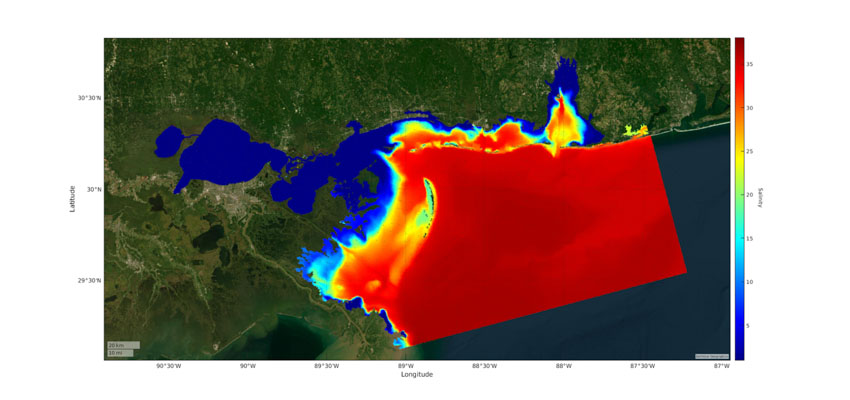USM SOSE Researchers Use Models to Forecast Bonnet Carre Spillway Effects on Coastal Oyster Population
Wed, 12/13/2023 - 09:12am | By: Gabriela Shinskie
Located in St. Charles Parish, La. and 12 miles west of New Orleans, the Bonnet Carré Spillway (BCS) provides a protective flood-control barrier to the Crescent City, diverting excess waters from the Mississippi River through Lake Pontchartrain on their way into the Gulf of Mexico.
Because of the mixing of fresh and saltwater in this situation, concern has grown as researchers have noticed a drastic decline in oyster population. This has led to The University of Southern Mississippi (USM) forming a team from its School of Ocean Science and Engineering (SOSE) to study the effects of this excess freshwater being diverted into Mississippi coastal waters, along with the fate of the coastal marine habitats.
Dr. Kemal Cambazoglu, an assistant professor in the SOSE, is also concerned about the situation yet hopeful the ocean modeling research team can provide helpful guidance.
“A large amount of freshwater gets diverted from the Mississippi River into Lake Pontchartrain through the spillway,” Dr. Cambazoglu said. “That freshwater fills the lake, which is connected to Mississippi Sound and Lake Borgne. When it gets to the Sound, it can cause significant shellfish mortality at the historic reefs and oyster beds in the Sound.”
When the river flow exceeds 1.25 million cubic feet per second at the Carrollton gage station. usually because of northern rainfall, snow/ice melting and/or runoff in springtime, the spillway is opened. The BCS was built following the Great Mississippi Flood of 1927 and was first used in 1937 by the Army Corps of Engineers. Typically, the spillway has opened about once a decade; however, since 2018, the spillway has opened multiple years in a row, including twice a year (in 2019) due to high waters.
“Utilization of the spillway for the diversion of MS River waters has been occurring more frequently than ever before,” said Dr. Cambazoglu.

Bottom salinity distribution on July 1st, 2019, during the second Bonnet Carré Spillway opening of 2019 predicted by the USM group’s coastal model. Prolonged exposure to salinity values < 5 are detrimental to the oyster beds of MS Sound.
According to the Mississippi Department of Marine Resources (MDMR), when oysters are exposed to low salinities caused by freshwater mixing over extended periods of time, the population declines. MDMR has performed extensive research showing the disappearance of oyster populations during each spillway opening.
In 2019, Dr. Jerry Wiggert of the SOSE and Dr. Cambazoglu were contacted by MDMR to apply their coastal forecasting system to provide guidance on what expected impacts look like to the coastal environment. The models factor in wind, water flow, and help implement ideas on best practices for spillway operations.
“Forecast modeling allows us to project, when there is any opening, where the freshwater will go,” Dr. Wiggert said. “This will give resource management information to explain how the impacts are endangering the coastal waters and habitat.”
Dr. Cambazoglu is also a co-lead investigator on a US Coastal Research Program project funded by The U.S. Army Corps of Engineers to provide research focusing on different operational procedures of the spillway along with its effects on coastal waters. Models from USM will provide insights into these implications.
“The triggers and decision points for spillway operations are not necessarily accounting for how Mississippi coastal waters will be affected,” said Dr. Wiggert who is a principal investigator on the same project.
The origin of the group’s coastal model was an outcome of the GoMRI-funded CONCORDE consortium led by Dr. Wiggert that was established in response to the Deepwater Horizon Spill, with further development of the model system supported by funding from the Army Corp’s Engineer Research and Development Center, the Mississippi Based RESTORE Act Center of Excellence, and MDMR. Drs. Wiggert and Cambazoglu have brought in a number of USM students to contribute to the research. Brandy Armstrong, a SOSE doctoral student, has extensive marine science, oceanography and sediment transport experience. Armstrong took on the role of providing MDMR experiments and model results of the impacts of mixing during openings.
“I expanded the model to include Lakes Maurepas and Pontchartrain, and added the Spillway as a mixing structure that allows for simulating freshwater diversion when the Spillway is active,” said Armstrong.
“For Brandy to join our group was really a boost in capability,” Dr. Wiggert noted. “Now we have a code developer with extensive understanding of the nuts and bolts of the modeling system our group is running.”
The team hopes to provide government agencies with spillway operations recommendations that can contribute to saving and maintaining coastal oyster beds. With help from USM researchers and scientists, the outcome could be beneficial and historical.
“For us modelers, it’s never-ending work improving the capabilities of our models to provide the best-possible scientific guidance to decision makers,” said Dr. Cambazoglu.
Learn more about USM’s School of Ocean Science and Engineering and how students and researchers are paving the way for a livable Gulf Coast in the blue economy.